Earnings-per-share-每股收益
股票上的英文字母代表什么意思

股票上的英文字母代表什么意思股票市场中的英文字母代表一些特定的意思,如下:1. IPO:Initial Public Offering(首次公开募股),指企业首次发行股票公开募集资金,正式进入证券市场。
2. PE:Price-to-Earnings Ratio(市盈率),指每股股价与每股收益的比率,用于评估一只股票的相对估值。
3. EPS:Earnings Per Share(每股收益),指公司净利润除以发行在外的普通股数量,反映了每股普通股股东所持有的收益。
4. P/E Ratio:Price-to-Earnings Ratio(市盈率),即市场价格和公司每股收益的比率,反映了市场对公司盈利能力的预期。
5. ADR:American Depositary Receipt(美国存托凭证),是美国证券交易市场上的一种工具,代表一家在美国以外发行的股票。
ADR是以美元计价的,并在美国交易所上市。
6. ETF:Exchange-Traded Fund(交易所交易基金),是一种类似于股票的投资基金,追踪特定的指数,投资者可以通过证券交易所进行买卖。
7. AGM:Annual General Meeting(年度股东大会),是上市公司每年召开的全体股东大会,股东在此会上审议公司的年度财务报告、选举董事会成员等重要事项。
8. CEO:Chief Executive Officer(首席执行官),是公司最高管理层的职位,负责领导公司的日常运营和制定战略决策。
9. CFO:Chief Financial Officer(首席财务官),是负责公司财务管理和财务战略的高级管理人员。
10. IPO:Initial Public Offering(首次公开募股),指公司将私有化的股份首次向公众发行,正式进入公开交易市场。
这些英文字母代表了股票市场中特定的概念、指标或职位,对于投资者、分析师和市场参与者具有重要的参考意义。
EPS、ROE、PE、PB、PEG,dcf 指标的含义
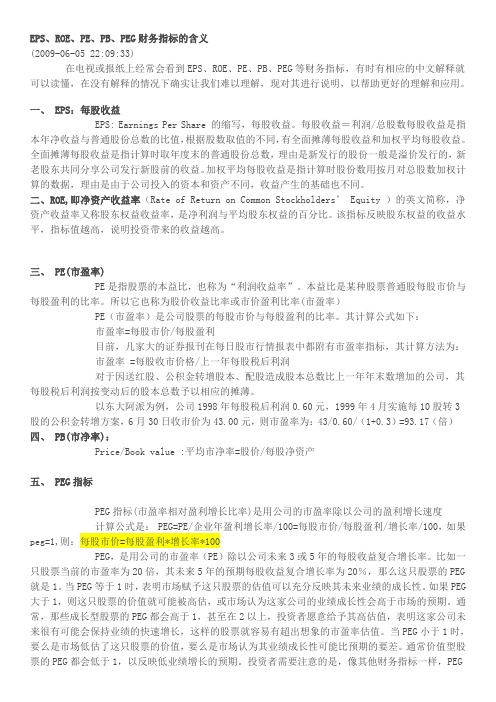
EPS、ROE、PE、PB、PEG财务指标的含义(2009-06-05 22:09:33)在电视或报纸上经常会看到EPS、ROE、PE、PB、PEG等财务指标,有时有相应的中文解释就可以读懂,在没有解释的情况下确实让我们难以理解,现对其进行说明,以帮助更好的理解和应用。
一、 EPS:每股收益EPS: Earnings Per Share 的缩写,每股收益。
每股收益=利润/总股数每股收益是指本年净收益与普通股份总数的比值,根据股数取值的不同,有全面摊薄每股收益和加权平均每股收益。
全面摊薄每股收益是指计算时取年度末的普通股份总数,理由是新发行的股份一般是溢价发行的,新老股东共同分享公司发行新股前的收益。
加权平均每股收益是指计算时股份数用按月对总股数加权计算的数据,理由是由于公司投入的资本和资产不同,收益产生的基础也不同。
二、ROE,即净资产收益率(Rate of Return on Common Stockholders’ Equity )的英文简称,净资产收益率又称股东权益收益率,是净利润与平均股东权益的百分比。
该指标反映股东权益的收益水平,指标值越高,说明投资带来的收益越高。
三、 PE(市盈率)PE是指股票的本益比,也称为“利润收益率”。
本益比是某种股票普通股每股市价与每股盈利的比率。
所以它也称为股价收益比率或市价盈利比率(市盈率)PE(市盈率)是公司股票的每股市价与每股盈利的比率。
其计算公式如下:市盈率=每股市价/每股盈利目前,几家大的证券报刊在每日股市行情报表中都附有市盈率指标,其计算方法为:市盈率 =每股收市价格/上一年每股税后利润对于因送红股、公积金转增股本、配股造成股本总数比上一年年末数增加的公司,其每股税后利润按变动后的股本总数予以相应的摊薄。
以东大阿派为例,公司1998年每股税后利润0.60元,1999年4月实施每10股转3股的公积金转增方案,6月30日收市价为43.00元,则市盈率为:43/0.60/(1+0.3)=93.17(倍)四、 PB(市净率):Price/Book value :平均市净率=股价/每股净资产五、 PEG指标PEG指标(市盈率相对盈利增长比率)是用公司的市盈率除以公司的盈利增长速度计算公式是: PEG=PE/企业年盈利增长率/100=每股市价/每股盈利/增长率/100,如果peg=1,则:每股市价=每股盈利*增长率*100PEG,是用公司的市盈率(PE)除以公司未来3或5年的每股收益复合增长率。
EPS、ROE、PE、PB、PEG财务指标的含义
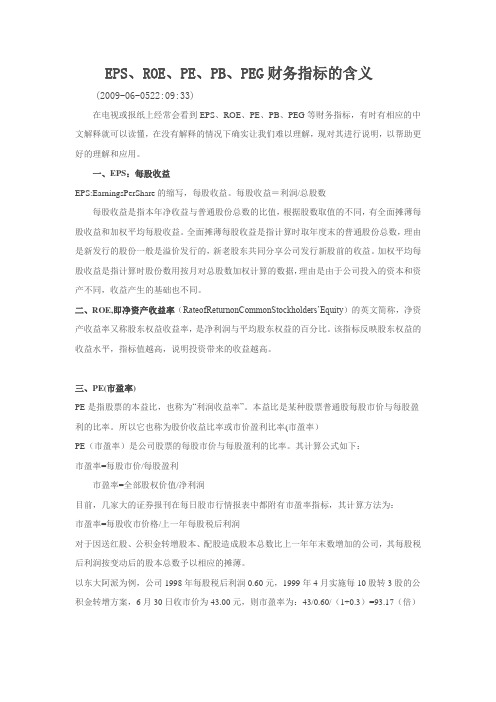
EPS、ROE、PE、PB、PEG财务指标的含义(2009-06-0522:09:33)在电视或报纸上经常会看到EPS、ROE、PE、PB、PEG等财务指标,有时有相应的中文解释就可以读懂,在没有解释的情况下确实让我们难以理解,现对其进行说明,以帮助更好的理解和应用。
一、EPS:每股收益EPS:EarningsPerShare的缩写,每股收益。
每股收益=利润/总股数每股收益是指本年净收益与普通股份总数的比值,根据股数取值的不同,有全面摊薄每股收益和加权平均每股收益。
全面摊薄每股收益是指计算时取年度末的普通股份总数,理由是新发行的股份一般是溢价发行的,新老股东共同分享公司发行新股前的收益。
加权平均每股收益是指计算时股份数用按月对总股数加权计算的数据,理由是由于公司投入的资本和资产不同,收益产生的基础也不同。
二、ROE,即净资产收益率(RateofReturnonCommonStockholders’Equity)的英文简称,净资产收益率又称股东权益收益率,是净利润与平均股东权益的百分比。
该指标反映股东权益的收益水平,指标值越高,说明投资带来的收益越高。
三、PE(市盈率)PE是指股票的本益比,也称为“利润收益率”。
本益比是某种股票普通股每股市价与每股盈利的比率。
所以它也称为股价收益比率或市价盈利比率(市盈率)PE(市盈率)是公司股票的每股市价与每股盈利的比率。
其计算公式如下:市盈率=每股市价/每股盈利市盈率=全部股权价值/净利润目前,几家大的证券报刊在每日股市行情报表中都附有市盈率指标,其计算方法为:市盈率=每股收市价格/上一年每股税后利润对于因送红股、公积金转增股本、配股造成股本总数比上一年年末数增加的公司,其每股税后利润按变动后的股本总数予以相应的摊薄。
以东大阿派为例,公司1998年每股税后利润0.60元,1999年4月实施每10股转3股的公积金转增方案,6月30日收市价为43.00元,则市盈率为:43/0.60/(1+0.3)=93.17(倍)四、PB(市净率):Price/Bookvalue:平均市净率=股价市价/每股净资产市净率=全部股权价值/全部净资产五、PEG指标PEG指标(市盈率相对盈利增长比率)是用公司的市盈率除以公司的盈利增长速度计算公式是:PEG=PE/企业年盈利增长率/100PEG,是用公司的市盈率(PE)除以公司未来3或5年的每股收益复合增长率。
CFAFRM金融分析公式大全

CFAFRM金融分析公式大全金融分析是评估公司、项目或投资的财务状况和潜力的过程。
在金融分析中,有许多重要的公式和指标,可以帮助分析师更好地理解和评估财务数据。
以下是一些常用的CFA和FRM金融分析公式:1. 盈余比(Earnings Ratio):盈余比是指公司的净收入与其市值之间的比率。
公式如下:盈余比=净收入/市值2. 市盈率(Price-Earnings Ratio):市盈率是指公司的市值与其每股盈余之间的比率。
公式如下:市盈率=市值/每股盈余3. 每股收益(Earnings per Share,EPS):每股收益是指公司的净收入在每一股普通股上的分配。
公式如下:每股收益=净收入/普通股数量4. 盈余增长率(Earnings Growth Rate):盈余增长率是指公司的净收入在一定时间内的年均增长率。
公式如下:盈余增长率=(本期净收入-上期净收入)/上期净收入*100%5. 资产收益率(Return on Assets,ROA):资产收益率是指公司净收入与其总资产之间的比率。
公式如下:资产收益率=净收入/总资产6. 资本收益率(Return on Equity,ROE):资本收益率是指公司净收入与其股东权益之间的比率。
公式如下:资本收益率=净收入/股东权益7. 负债比率(Debt Ratio):负债比率是指公司负债金额与其总资产之间的比率。
公式如下:负债比率=负债金额/总资产8. 流动比率(Current Ratio):流动比率是指公司流动资产与流动负债之间的比率。
公式如下:流动比率=流动资产/流动负债9. 速动比率(Quick Ratio):速动比率是指公司流动资产中的快速可变现资产与流动负债之间的比率。
公式如下:速动比率=(流动资产-存货)/流动负债10. 现金比率(Cash Ratio):现金比率是指公司现金与流动负债之间的比率。
公式如下:现金比率=现金/流动负债11. 总资产周转率(Total Asset Turnover):总资产周转率是指公司销售收入与其总资产之间的比率。
上市公司主要财务指标分析

上市公司主要财务主标分析一:每股收益每股收益(Earning Per Share,简称EPS),又称每股税后利润、每股盈余,指税后利润与股本总数的比率。
它是测定股票投资价值的重要指标之一,是分析每股价值的一个基础性指标,是综合反映公司获利能力的重要指标,它是公司某一时期净收益与股份数的比率。
该比率反映了每股创造的税后利润, 比率越高, 表明所创造的利润越多。
若公司只有普通股时,净收益是税后净利,股份数是指流通在外的普通股股数。
如果公司还有优先股,应从税后净利中扣除分派给优先股东的利息。
每股收益=利润/总股数并不是每股盈利越高越好,因为每股有股价利润100W,股数100W股10元/股,总资产1000W利润率=100/1000*100%=10%每股收益=100W/100W=1元利润100W,股数50W股40元/股,总资产2000W利润率=100/2000*100%=5%每股收益=100W/50W=2元传统的每股收益指标计算公式为:每股收益=(本期净利润- 优先股股利)/期末流通在外的普通股股一般的投资者在使用该财务指标时有以下几种方式:一、通过每股收益指标排序,是用来寻找所谓“绩优股”和“垃圾股”;二、横向比较同行业的每股收益来选择龙头企业;三、纵向比较个股的每股收益来判断该公司的成长性。
每股收益仅仅代表的是某年每股的收益情况,基本不具备延续性,因此不能够将它单独作为作为判断公司成长性的指标。
我国的上市公司很少分红利,大多数时候是送股,同时为了融资会选择增发和配股或者发行可转换公司债券,所有这些行为均会改变总股本。
由每股收益的计算公式我们可以看出,如果总股本发生变化每股收益也会发生相反的变化。
这个时候我们再纵向比较每股收益的增长率你会发现,很多公司都没有很高的增长率,甚至是负增长。
G宇通就是这样的典型代表。
每股收益在逐年递减的同时,净利润却一直保持在以10%以上的增长率。
二:基本每股收益股份公司中的每股利润(Earnings Per Share,缩写EPS)是指普通股每股税后利润。
EPS、ROE、PE、PB、PEG财务指标的含义
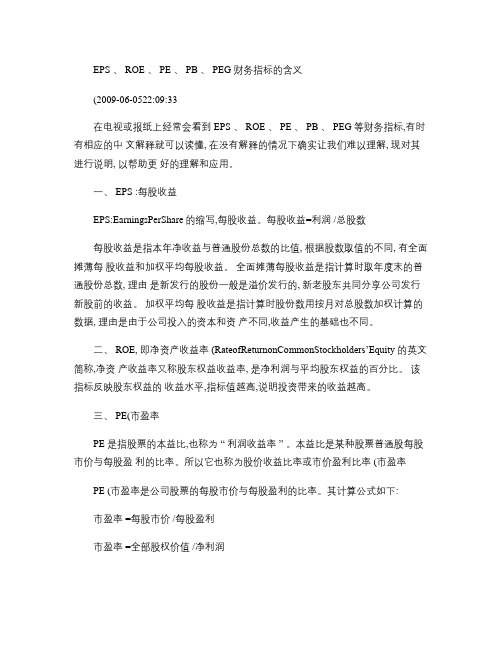
EPS 、 ROE 、 PE 、 PB 、 PEG 财务指标的含义(2009-06-0522:09:33在电视或报纸上经常会看到 EPS 、 ROE 、 PE 、 PB 、 PEG 等财务指标,有时有相应的中文解释就可以读懂, 在没有解释的情况下确实让我们难以理解, 现对其进行说明, 以帮助更好的理解和应用。
一、 EPS :每股收益EPS:EarningsPerShare的缩写,每股收益。
每股收益=利润 /总股数每股收益是指本年净收益与普通股份总数的比值, 根据股数取值的不同, 有全面摊薄每股收益和加权平均每股收益。
全面摊薄每股收益是指计算时取年度末的普通股份总数, 理由是新发行的股份一般是溢价发行的, 新老股东共同分享公司发行新股前的收益。
加权平均每股收益是指计算时股份数用按月对总股数加权计算的数据, 理由是由于公司投入的资本和资产不同,收益产生的基础也不同。
二、 ROE, 即净资产收益率(RateofReturnonCommonStockholders’Equity 的英文简称,净资产收益率又称股东权益收益率, 是净利润与平均股东权益的百分比。
该指标反映股东权益的收益水平,指标值越高,说明投资带来的收益越高。
三、 PE(市盈率PE 是指股票的本益比,也称为“ 利润收益率” 。
本益比是某种股票普通股每股市价与每股盈利的比率。
所以它也称为股价收益比率或市价盈利比率 (市盈率PE (市盈率是公司股票的每股市价与每股盈利的比率。
其计算公式如下:市盈率 =每股市价 /每股盈利市盈率 =全部股权价值 /净利润目前,几家大的证券报刊在每日股市行情报表中都附有市盈率指标,其计算方法为:市盈率 =每股收市价格 /上一年每股税后利润对于因送红股、公积金转增股本、配股造成股本总数比上一年年末数增加的公司, 其每股税后利润按变动后的股本总数予以相应的摊薄。
以东大阿派为例,公司 1998年每股税后利润 0.60元, 1999年 4月实施每 10股转 3股的公积金转增方案, 6月 30日收市价为 43.00元,则市盈率为:43/0.60/(1+0.3 =93.17(倍四、 PB(市净率 :Price/Bookvalue:平均市净率 =股价市价 /每股净资产市净率 =全部股权价值 /全部净资产五、 PEG 指标PEG 指标 (市盈率相对盈利增长比率是用公司的市盈率除以公司的盈利增长速度计算公式是:PEG=PE/企业年盈利增长率 /100PEG ,是用公司的市盈率(PE 除以公司未来 3或 5年的每股收益复合增长率。
稀释每股收益是什么意思

稀释每股收益是什么意思在财务会计中,稀释每股收益(Diluted Earnings Per Share, EPS)是一个重要的金融指标,用于衡量公司每股普通股的收益能力。
它是指如果公司的潜在普通股股东全部行使其价格低于股票市价的可转换债券、股权选择权或股份分发权益等可转换证券,以及公司应付普通股股东的累计股息,并将所有这些潜在普通股股份加入到公司的普通股股份中,每股收益将会相对稀释的程度。
稀释每股收益是投资者、分析师和利益相关者评估公司潜在风险和价值的关键指标之一。
它提供了更全面和准确的信息,以帮助投资者更好地理解公司的盈利能力和潜在风险。
值得注意的是,稀释每股收益通常低于基本每股收益,因为它考虑了可转换证券的潜在股份,并反映了这些潜在股东的权益。
为了计算稀释每股收益,需要考虑以下潜在股份的影响:1. 可转换债券:如果公司发行了可转换债券,债券持有人有权将债券转换为公司的股票。
在计算稀释每股收益时,需要将可能转换的债券视为已经转换为普通股。
2. 股权选择权:公司可能给予职员、高管或其他特定人员购买公司股票的权利,这被称为股权选择权。
如果这些权利被行使,公司的股东权益会相应稀释。
3. 优先股:如果公司发行了优先股,尤其是有权转换为普通股的优先股,那么在计算稀释每股收益时,应将这些潜在普通股加入到公司的普通股份中。
4. 股份分发权益:有些公司会发放股份分发权益,让股东以较低的价格购买额外的股份。
在计算稀释每股收益时,需要考虑这些潜在股份的影响。
稀释每股收益的计算方法是将公司净收入减去优先股股息,然后将结果除以基本普通股的数量,再加上潜在普通股的数量。
具体公式如下:稀释每股收益 = (公司净收入 - 优先股股息) / (基本普通股数量 +转换后潜在普通股数量)通过计算稀释每股收益,投资者可以更准确地衡量公司的收益能力,并考虑潜在股东对于普通股股份的稀释效果。
较低的稀释每股收益可能意味着公司的收益能力较好,并且潜在风险较小。
earnings yield计算公式
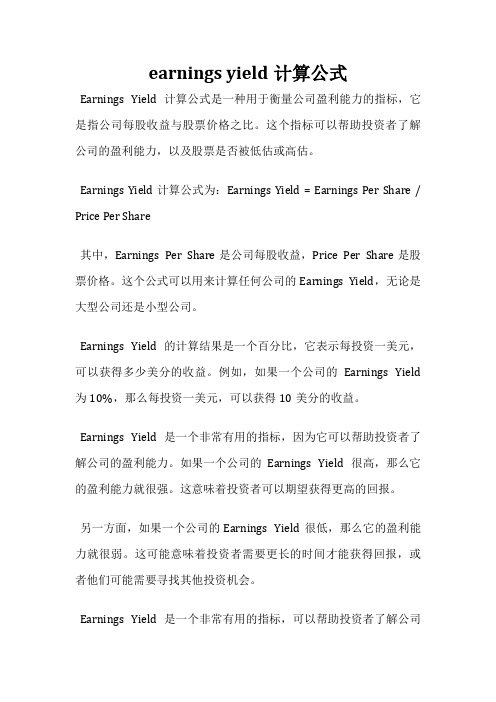
earnings yield计算公式
Earnings Yield计算公式是一种用于衡量公司盈利能力的指标,它是指公司每股收益与股票价格之比。
这个指标可以帮助投资者了解公司的盈利能力,以及股票是否被低估或高估。
Earnings Yield计算公式为:Earnings Yield = Earnings Per Share / Price Per Share
其中,Earnings Per Share是公司每股收益,Price Per Share是股票价格。
这个公式可以用来计算任何公司的Earnings Yield,无论是大型公司还是小型公司。
Earnings Yield的计算结果是一个百分比,它表示每投资一美元,可以获得多少美分的收益。
例如,如果一个公司的Earnings Yield 为10%,那么每投资一美元,可以获得10美分的收益。
Earnings Yield是一个非常有用的指标,因为它可以帮助投资者了解公司的盈利能力。
如果一个公司的Earnings Yield很高,那么它的盈利能力就很强。
这意味着投资者可以期望获得更高的回报。
另一方面,如果一个公司的Earnings Yield很低,那么它的盈利能力就很弱。
这可能意味着投资者需要更长的时间才能获得回报,或者他们可能需要寻找其他投资机会。
Earnings Yield是一个非常有用的指标,可以帮助投资者了解公司
的盈利能力。
如果投资者想要获得更高的回报,他们应该寻找具有高Earnings Yield的公司。
盈利能力分析指标
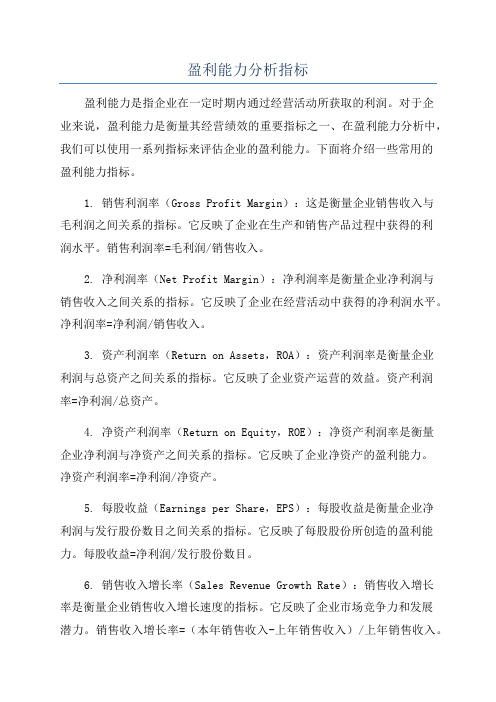
盈利能力分析指标盈利能力是指企业在一定时期内通过经营活动所获取的利润。
对于企业来说,盈利能力是衡量其经营绩效的重要指标之一、在盈利能力分析中,我们可以使用一系列指标来评估企业的盈利能力。
下面将介绍一些常用的盈利能力指标。
1. 销售利润率(Gross Profit Margin):这是衡量企业销售收入与毛利润之间关系的指标。
它反映了企业在生产和销售产品过程中获得的利润水平。
销售利润率=毛利润/销售收入。
2. 净利润率(Net Profit Margin):净利润率是衡量企业净利润与销售收入之间关系的指标。
它反映了企业在经营活动中获得的净利润水平。
净利润率=净利润/销售收入。
3. 资产利润率(Return on Assets,ROA):资产利润率是衡量企业利润与总资产之间关系的指标。
它反映了企业资产运营的效益。
资产利润率=净利润/总资产。
4. 净资产利润率(Return on Equity,ROE):净资产利润率是衡量企业净利润与净资产之间关系的指标。
它反映了企业净资产的盈利能力。
净资产利润率=净利润/净资产。
5. 每股收益(Earnings per Share,EPS):每股收益是衡量企业净利润与发行股份数目之间关系的指标。
它反映了每股股份所创造的盈利能力。
每股收益=净利润/发行股份数目。
6. 销售收入增长率(Sales Revenue Growth Rate):销售收入增长率是衡量企业销售收入增长速度的指标。
它反映了企业市场竞争力和发展潜力。
销售收入增长率=(本年销售收入-上年销售收入)/上年销售收入。
7. 净利润增长率(Net Profit Growth Rate):净利润增长率是衡量企业净利润增长速度的指标。
它反映了企业经营活动的盈利能力变化。
净利润增长率=(本年净利润-上年净利润)/上年净利润。
8. 经营现金流量净额(Net Cash Flow from Operations):经营现金流量净额是衡量企业经营活动现金流量的指标。
股票的各种英文缩写及应用

股票的各种英文缩写及应用
以下是一些股票常用的英文缩写及其应用:
1. IPO - Initial Public Offering,指公司首次公开发行股票。
2. EPS - Earnings Per Share,指每股收益。
3. P/E - Price-to-Earnings,指市盈率,是一个衡量公司盈利情况的指标。
4. ADR - American Depositary Receipt,指美国存托凭证,是在美国证券市场发行的外国公司股票。
5. ETF - Exchange-Traded Fund,指交易所交易基金,是一种可在证券市场上买卖的基金。
6. REIT - Real Estate Investment Trust,指房地产投资信托,是一种以投资房地产为主要目的的公司。
7. SEC - Securities and Exchange Commission,指美国证券交易委员会,是负责监管证券市场的机构。
8. NDA - Non-Disclosure Agreement,指保密协议,是一种法律文件,在区域合约中展示了参与者之间的信息共享限制。
9. CEO - Chief Executive Officer,指首席执行官,是公司的最高管理者。
10. CFO - Chief Financial Officer,指首席财务官,负责公司的财务管理。
这只是一小部分股票相关的英文缩写。
不同国家和不同领域的股票可能会有不同的缩写。
在研究股票投资时,可以参考相关金融和投资资料,了解更多的英文缩
写和其应用。
reits核心指标

reits核心指标房地产投资信托(Real Estate Investment Trusts,REITs)的核心指标涉及多个方面,其中一些主要的指标包括:1.资产规模(Asset Size):•衡量REITs所拥有的房地产资产的规模。
较大的资产规模通常能够提供更大的收入和分散化风险。
2.净资产值(Net Asset Value,NAV):•表示REITs的总资产减去总负债的价值。
NAV是一个重要的财务指标,反映了REITs的净值状况。
3.每股收益(Earnings Per Share,EPS):•衡量REITs在一定时间内每股股票的收益。
这是投资者评估REITs盈利能力的一个重要指标。
4.分红收益率(Dividend Yield):•表示REITs每股分红的金额占股价的百分比。
分红是REITs 主要的吸引投资者的特点之一,因此分红收益率是一个关键的投资考量。
5.资金利用率(Occupancy Rate):•表示REITs房地产资产中已租赁空间的百分比。
高的资金利用率通常表明REITs的房地产投资受到了市场的认可。
6.资产净值回报率(Return on Net Assets,RONA):•表示REITs通过其房地产资产实现的净利润占总资产净值的百分比。
7.债务水平(Debt Levels):•衡量REITs的负债水平。
较低的债务水平可能意味着REITs 的财务状况较好,但也可能表明其在扩张方面的限制。
8.股价净值比(Price-to-NAV Ratio):•衡量REITs的股价相对于其净资产值的比率。
这可以帮助投资者评估股价是高估还是低估。
9.运营效率和管理费用(Operating Efficiency and ManagementFees):•衡量REITs运营效率的指标,以及管理费用占总资产的比例。
这些指标可以帮助投资者了解一个REITs的财务状况、盈利能力、分红政策以及市场表现。
在进行投资决策时,投资者通常会综合考虑这些指标,并根据自己的投资目标和风险承受能力来做出决策。
怎样看每股收益+公式
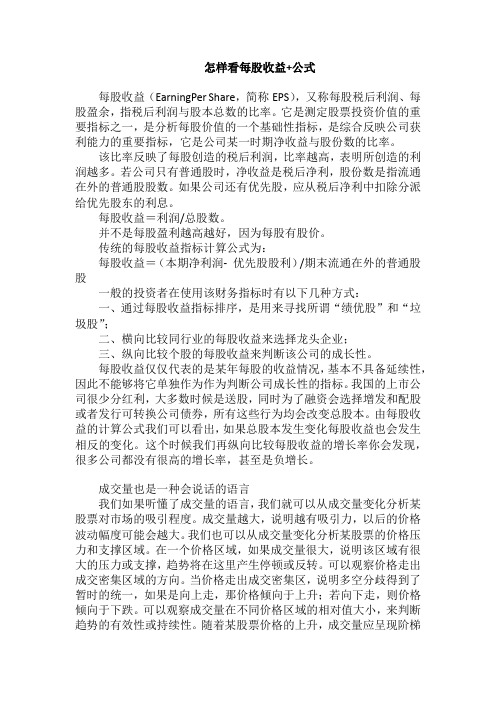
怎样看每股收益+公式每股收益(EarningPer Share,简称EPS),又称每股税后利润、每股盈余,指税后利润与股本总数的比率。
它是测定股票投资价值的重要指标之一,是分析每股价值的一个基础性指标,是综合反映公司获利能力的重要指标,它是公司某一时期净收益与股份数的比率。
该比率反映了每股创造的税后利润,比率越高,表明所创造的利润越多。
若公司只有普通股时,净收益是税后净利,股份数是指流通在外的普通股股数。
如果公司还有优先股,应从税后净利中扣除分派给优先股东的利息。
每股收益=利润/总股数。
并不是每股盈利越高越好,因为每股有股价。
传统的每股收益指标计算公式为:每股收益=(本期净利润- 优先股股利)/期末流通在外的普通股股一般的投资者在使用该财务指标时有以下几种方式:一、通过每股收益指标排序,是用来寻找所谓“绩优股”和“垃圾股”;二、横向比较同行业的每股收益来选择龙头企业;三、纵向比较个股的每股收益来判断该公司的成长性。
每股收益仅仅代表的是某年每股的收益情况,基本不具备延续性,因此不能够将它单独作为作为判断公司成长性的指标。
我国的上市公司很少分红利,大多数时候是送股,同时为了融资会选择增发和配股或者发行可转换公司债券,所有这些行为均会改变总股本。
由每股收益的计算公式我们可以看出,如果总股本发生变化每股收益也会发生相反的变化。
这个时候我们再纵向比较每股收益的增长率你会发现,很多公司都没有很高的增长率,甚至是负增长。
成交量也是一种会说话的语言我们如果听懂了成交量的语言,我们就可以从成交量变化分析某股票对市场的吸引程度。
成交量越大,说明越有吸引力,以后的价格波动幅度可能会越大。
我们也可以从成交量变化分析某股票的价格压力和支撑区域。
在一个价格区域,如果成交量很大,说明该区域有很大的压力或支撑,趋势将在这里产生停顿或反转。
可以观察价格走出成交密集区域的方向。
当价格走出成交密集区,说明多空分歧得到了暂时的统一,如果是向上走,那价格倾向于上升;若向下走,则价格倾向于下跌。
财务指标解释

EPS是每股盈余(Earnings Per Share)的缩写,指普通股每股税后利润。
EPS(每股盈余)=盈余/流通在外股数。
EPS为公司获利能力的最后结果。
每股盈余高代表着公司每单位资本额的获利能力高,这表示公司具有某种较佳的能力——产品行销、技术能力、管理能力等等,使得公司可以用较少的资源创造出较高的获利。
本业的每股获利,通常也代表着该年度所能配发的股利。
如果以股利收入的角度来选股,则可以eps作为替代变数。
ROE 净资产收益率又称股东权益收益率,是净利润与平均股东权益的百分比,是公司税后利润除以净资产得到的百分比率,该指标反映股东权益的收益水平,用以衡量公司运用自有资本的效率。
指标值越高,说明投资带来的收益越高。
ROA 资产收益率,也叫资产回报率(ROA),它是用来衡量每单位资产创造多少净利润的指标。
PE 市盈率(Price to Earning Ratio,简称PE或P/E Ratio) ,也称本益比“股价收益比率”或“市价盈利比率(简称市盈率)” 。
市盈率是最常用来评估股价水平是否合理的指标之一,由股价除以年度每股盈余(EPS)得出(以公司市值除以年度股东应占溢利亦可得出相同结果)。
PEG=PE(当前动态市盈率)/100/g(未来几年预计复合增长率),一般认为PEG越低的公司具有较好的投资价值,PEG=1往往被作为是否有投资价值的分水岭。
其实PEG指标在成熟市场中较多运用在科技类或成长类公司估值上,因为较高的增长率使得PE/PB等传统指标失效,而未来现金流又非常不好预测。
PER(X) 动态市盈率是指还没有真正实现的下一年度的预测利润的市盈率。
等于股票现价和未来每股收益的预测值的比值,比如下年的动态市盈率就是股票现价除以下一年度每股收益预测值,后年的动态市盈率就是现价除以后年每股收益。
加权平均每股收益计算公式

加权平均每股收益计算公式加权平均每股收益(Weighted average earnings per share)是一种计算上市公司每股收益的方法,它考虑了不同期间的每股收益,并根据各期间的权重进行加权平均计算。
这种方法在分析公司盈利的稳定性和持续性时非常有用。
计算加权平均每股收益的公式如下:其中,NI代表每期的净利润,W代表该期间的权重。
权重通常可以通过期间的时间长度来确定,也可以根据其重要性或其他因素进行设定。
为了更好地理解加权平均每股收益的计算方法,我们可以通过一个例子来进行说明。
假设一家公司在年初第一季度实现净利润为100万元,第二季度实现净利润为200万元,第三季度实现净利润为150万元,年末第四季度实现净利润为300万元。
这里我们假设每个季度的长度是相等的,为3个月。
首先,需要确定每个季度的权重。
由于每个季度的时间长度相等,我们可以将每个季度的权重设定为1然后,将每期的净利润乘以对应的权重,然后将所有乘积相加。
(100万元*1+200万元*1+150万元*1+300万元*1)=750万元最后,将乘积的总和除以权重的总和。
750万元/(1+1+1+1)=750万元/4=187.5万元所以,这家公司的加权平均每股收益为187.5万元。
美国会计准则(USGAAP)和国际财务报告准则(IFRS)均对加权平均每股收益的计算方法进行了规定。
按照这些准则的要求,上市公司需要在财务报表中披露加权平均每股收益数据,以便投资者和分析师能够更全面地了解公司的盈利情况。
总而言之,加权平均每股收益是一种有效的计算上市公司每股收益的方法。
通过考虑不同期间的净利润和权重,它能够提供更准确和稳定的每股收益数据,为投资者和分析师提供更全面的盈利信息。
基本面指标编码规则

基本面指标的编码规则可能因不同的行业、公司和国家而异。
通常情况下,基本面指标的编码规则通常由行业标准和金融市场的约定而定。
以下是一些常见的基本面指标和它们的编码规则示例:1. 财务指标:- 总收入:编码为"revenue"或类似的简写,例如"REV"。
- 净利润:编码为"net income"或简写为"NI"。
- 每股收益(EPS):编码为"earnings per share"或简写为"EPS"。
- 资产负债表中的总资产:编码为"total assets"或简写为"TA"。
- 资产负债表中的总负债:编码为"total liabilities"或简写为"TL"。
2. 经营指标:- 每股销售额:编码为"sales per share"或简写为"SPS"。
- 毛利率:编码为"gross margin"或简写为"GM"。
- 净利润率:编码为"net profit margin"或简写为"NPM"。
- 资本回报率(ROE):编码为"return on equity"或简写为"ROE"。
3. 市值指标:- 市盈率(P/E):编码为"price-to-earnings ratio"或简写为"P/E"。
- 市净率(P/B):编码为"price-to-book ratio"或简写为"P/B"。
- 市销率(P/S):编码为"price-to-sales ratio"或简写为"P/S"。
EPS EBIT
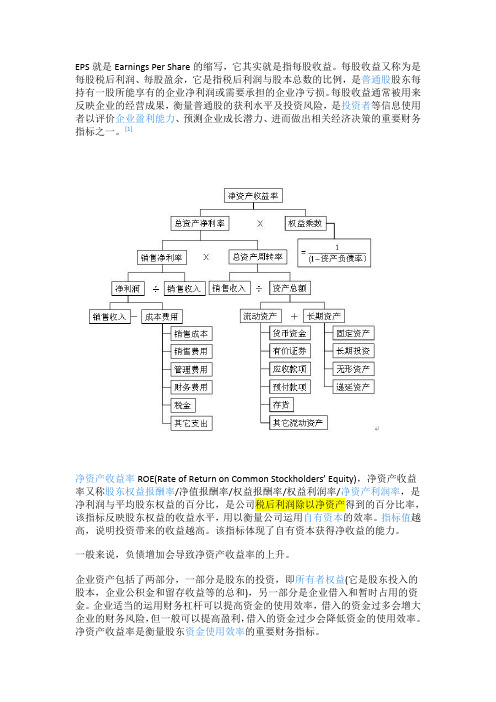
EPS就是Earnings Per Share的缩写,它其实就是指每股收益。
每股收益又称为是每股税后利润、每股盈余,它是指税后利润与股本总数的比例,是普通股股东每持有一股所能享有的企业净利润或需要承担的企业净亏损。
每股收益通常被用来反映企业的经营成果,衡量普通股的获利水平及投资风险,是投资者等信息使用者以评价企业盈利能力、预测企业成长潜力、进而做出相关经济决策的重要财务指标之一。
[1]净资产收益率ROE(Rate of Return on Common Stockholders’ Equity),净资产收益率又称股东权益报酬率/净值报酬率/权益报酬率/权益利润率/净资产利润率,是净利润与平均股东权益的百分比,是公司税后利润除以净资产得到的百分比率,该指标反映股东权益的收益水平,用以衡量公司运用自有资本的效率。
指标值越高,说明投资带来的收益越高。
该指标体现了自有资本获得净收益的能力。
一般来说,负债增加会导致净资产收益率的上升。
企业资产包括了两部分,一部分是股东的投资,即所有者权益(它是股东投入的股本,企业公积金和留存收益等的总和),另一部分是企业借入和暂时占用的资金。
企业适当的运用财务杠杆可以提高资金的使用效率,借入的资金过多会增大企业的财务风险,但一般可以提高盈利,借入的资金过少会降低资金的使用效率。
净资产收益率是衡量股东资金使用效率的重要财务指标。
WACC是英文Weighted Average Cost of Capital的缩写。
WACC代表公司整体平均资金成本,可用来衡量一个项目是否值得投资;项目的回报必须不低于WACC。
计算WACC时,先算出构成公司资本结构的各个项目如普通股、优先股、公司债及其他长期负债各自的资金成本或要求回报率,然后将这些回报率按各项目在资本结构中的权重加权,即可算出加权平均资本成本。
EBIT(earnings before interest and tax)是息税前利润,从字面意思可知是不扣除利息、所得税之前的利润。
ept财务术语

ept财务术语
EPT(英文全拼:Earnings Per Share,中文全称:每股收益)是一种常见的财务术语,用于衡量公司每股普通股票所获得的净利润。
它是通过将公司的净利润除以普通股的平均流通数量来计算的。
EPT可以提供有关公司盈利能力和每股价值的重要信息。
它被广泛用于投资者和分析师评估公司的盈利潜力和相对估值。
较高的EPT通常表示公司盈利能力较强,而较低的EPT则可能暗示着较低的盈利能力。
计算EPT的公式如下:
\[ EPT = \frac {净利润}{普通股的平均流通数量} \]
需要注意的是,由于会计规则和公司的财务报告差异,计算EPT时可能存在不同的变体。
此外,EPT还可以根据不同的时间段来计算,如季度EPT、年度EPT等,以提供更具体的财务信息。
- 1、下载文档前请自行甄别文档内容的完整性,平台不提供额外的编辑、内容补充、找答案等附加服务。
- 2、"仅部分预览"的文档,不可在线预览部分如存在完整性等问题,可反馈申请退款(可完整预览的文档不适用该条件!)。
- 3、如文档侵犯您的权益,请联系客服反馈,我们会尽快为您处理(人工客服工作时间:9:00-18:30)。
Earnings per shareEarnings per share (EPS) is the monetary value of earnings per each outstanding share of a company's common stock.In the United States, the Financial Accounting Standards Board (FASB) requires companies' income statements to report EPS for each major category of the income statement: continuing operations, discontinued operations, extraordinary items, and net income.Calculating EPSPreferred stock rights have precedence over common stock. Therefore, dividends declared on preferred shares are subtracted before calculating the EPS. When preferred shares are cumulative, the annual dividends are deducted whether they have been declared or not. Dividends in arrears are not relevant when calculating EPS.Earnings per share (basic formula)Earnings per share (net income formula)Earnings per share (continuing operations formula)References•WikipediaEarning per share, also called net income per share, is a market prospectratio that measures the amount of net income earned per share of stock outstanding. In other words, this is the amount of money each share of stock would receive if all of the profits were distributed to the outstanding shares at the end of the year.Earnings per share is also a calculation that shows how profitable a company is on a shareholder basis. So a larger company's profits per share can be compared to smaller company's profits per share. Obviously, this calculation is heavily influenced on how many shares are outstanding. Thus, a larger company will have to split its earning amongst many more shares of stock compared to a smaller company.FormulaEarnings per share or basic earnings per share is calculated by subtracting preferred dividends from net income and dividing by the weighted average common shares outstanding. The earnings per share formula looks like this.You'll notice that the preferred dividends are removed from net income in the earnings per share calculation. This is because EPS only measures the income available to common stockholders. Preferred dividends are set-aside for the preferred shareholders and can't belong to the common shareholders.Most of the time earning per share is calculated for year-end financial statements. Since companies often issue new stock and buy back treasury stock throughout the year, the weighted average common shares are used in the calculation. The weighted average common shares outstanding is can be simplified by adding the beginning and ending outstanding shares and dividing by two.AnalysisEarning per share is the same as any profitability or market prospect ratio. Higher earnings per share is always better than a lower ratio because this means the company is more profitable and the company has more profits to distribute to its shareholders.Although many investors don't pay much attention to the EPS, a higher earnings per share ratio often makes the stock price of a company rise. Since so many things can manipulate this ratio, investors tend to look at it but don't let it influence their decisions drastically.ExampleQuality Co. has net income during the year of $50,000. Since it is a small company, there are no preferred shares outstanding. Quality Co. had 5,000 weighted average shares outstanding during the year. Quality's EPS is calculated like this.As you can see, Quality's EPS for the year is $10. This means that if Quality distributed every dollar of income to its shareholders, each share would receive 10 dollars.Understanding Earnings Per ShareOne of the challenges of evaluating stocks is establishing an “apples to apples” comparison. What I mean by this is setting up a comparison that is meaningful so that the results help you make an investment decision.Comparing the price of two stocks is meaningless as I point out in myarticle “Why Per-Share Price is Not Important.”Similarly, comparing the earnings of one company to another really doesn’t make any sense, if you think about it. Using the raw numbers ignores the fact that the two companies undoubtedly have a different number of outstanding shares.For example, companies A and B both earn $100, but company A has 10 shares outstanding, while company B has 50 shares outstanding. Which company’s stock do you want to own?It makes more sense to look at earnings per share (EPS) for use as a comparison tool. You calculate earnings per share by taking the net earnings and divide by the outstanding shares.EPS = Net Earnings / Outstanding SharesUsing our example above, Company A had earnings of $100 and 10 shares outstanding, which equals an EPS of 10 ($100 / 10 = 10). Company B had earnings of $100 and 50 shares outstanding, which equals an EPS of 2 ($100 / 50 = 2).So, you should go buy Company A with an EPS of 10, right? Maybe, but not just on the basis of its EPS. The EPS is helpful in comparing one company to another, assuming they are in the same industry, but it doesn’t tell you whether it’s a good stock to buy or what the market thinks of it. For that information, we need to look at some ratios.Before we move on, you should note that there are three types of EPS numbers:•Trailing EPS – last year’s numbers and the only actual EPS •Current EPS – this year’s numbers, which are still projections •Forward EPS – future numbers, which are obviously projectionsThe articles in this series:3 WaysHow to Calculate Earnings Per ShareThree Methods:Basic Earnings Per Share CalculationWeighted Earnings Per Share CalculationUsing Earnings Per ShareEarnings per share (EPS) is a commonly used phrase in the financial world. Earnings per share represents a portion of a company's profit that is allocated to one share of stock. Therefore, if you were to multiply the EPS by the total number of shares a company has, you'd calculate the company's net income. EPS is a calculation that many people who watch the stock market pay attention to.Method 1 of 3: Basic Earnings Per Share Calculation1.1Locate the company's net earning or net income from the previous year. This information can be found on most financial webpages, or on the company's website. Using the company's net earnings or income as the primary number in the calculation is the most basic way of determining EPS.•For example, say you want to calculate the EPS of Microsoft based on its net income. A quick browse of Microsoft's website tells you that in 2012, the company's net income was almost $17 billion.[1]•Be careful not to mistake a company's quarterly net income with their annual net income.Quarterly profit is calculated every three months, whereas annual profit is calculated every12 months. Mistaking a company's quarterly net income for their annual net income willcause your calculation to be roughly four times smaller.2Figure out how many shares are outstanding. How many total shares does a company have on the stock exchange? This information can be collected by visiting a financial website and locating the company's information.•Again, let's continue with the example of Microsoft. As of the time of writing, Microsoft has8.33 billion shares outstanding.[2]3Divide the net income by the number of shares outstanding. Taking Microsoft's vitals as our example, we'd divide $17 billion by 8.33 billion and come away with a basic EPS of2.[3]•Take another basic example. Let's say a bocce ball company has a net income of $4 million and 575,000 shares outstanding. We divide $4 million by 575,000 and come up with an EPS of 6.95.Method 2 of 3: Weighted Earnings Per Share Calculation1.1Modify the basic EPS calculation slightly to arrive at the weighted earning per share calculation. Weighted EPS is a more accurate calculation because it takes into account any dividends that the company issues to shareholders. However, this formula is more complex than the basic earnings per share calculation or the reporting term, so it is not used quite as often even though it is more accurate.2.2Locate the company's dividends on preferred stocks. A dividend is an amount of money paid out to stockholders — often quarterly — from the company's profit.•For the sake of example, let's take Apple as the company we're trying to arrive at a calculation for. In 2012, Apple announced that it would pay a $2.5 billion dividend quarterly, starting in Q3.[4] That amounts to roughly $5 billion in dividends over the course of the year.3Take the company's net income and subtract the dividends on preferred stock number. Using Apple as an example, a quick search reveals that in 2012, Apple recorded $41.73 billion in net income.[5] Subtract $5 billion from 41.73 to arrive at $36.73 billion.4Divide the difference by the average number of outstanding shares. Apple's net income minus their dividend in 2012 was $36.73 billion. Divide this amount by the amount of shares outstanding, 934.82 million, to arrive at a weighted EPS of roughly 39.29.Method 3 of 3: Using Earnings Per Share1.1Use EPS as a barometer for a company's profitability. EPS clues investors and potential investors in to a company's profitability.[6] A higher EPS generally signals a more robust company, profit-wise. Like most numbers, however, EPS should not be looked at in isolation. There's no fixed EPS number above which a company's stock should be bought and below which its stock should be sold. It's important to look at a company's EPS in relation to other companies.2.2Know that more than other calculations, EPS is probably the single most important factor in driving a company's stock price.[7] Looking at a company's EPS is more valuable than looking at their profit because EPS puts a company's profit into perspective.(A huge company generating $1M net income isn't very impressive; a tiny companygenerating $1M net income is.) EPS is also integral in evaluating a company's Price to Earnings ratio, or P/E.3.3Know that calculating EPS is not enough to make an informed decision about whether to invest. EPS will tell you how one company is doing compared to another, or how one company is doing in relation to the industry as a whole, but it won't tell you at a glance whether it's a steal to invest in a company or whether that company is overvalued.In order to make an informed decision about whether to invest in a company's stock, you'll also need to consider the following, at the very least:•Market capitalization•Share price•Dividends/buybacks•Long-term financial outlook•Sufficient liquidityTips•When determining whether or not to invest in a company, EPS is often used in place of the total earnings reported by the company. This term is so widely used because it is aneasier way to represent how profitable a company truly is.•When performing these calculations, make note of the number of shares outstanding. The more shares involved, the more diluted the earnings per share results will be.•Nearly all of the information you need to perform these calculations can be found online.To find this information you will need to visit a finance site and look up the company's income statement and other statements.•Be aware if you are calculating the weighted EPS number, or the reporting number. In some situations the numbers barely differ but it is still important to know whether you are using the basic calculation for a more general estimate, or the weighted calculation that takes into account that numbers change over time.[8]。
